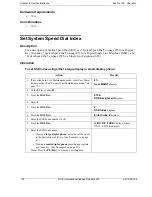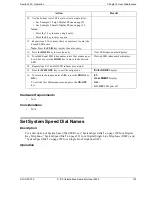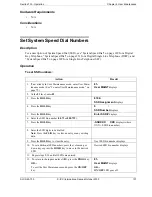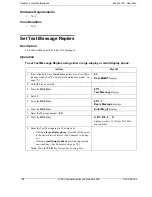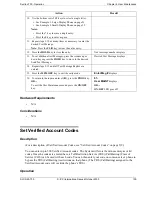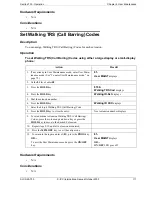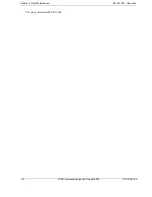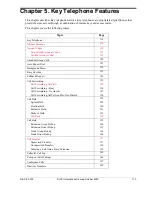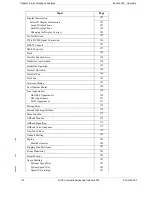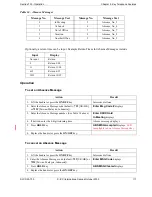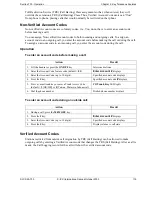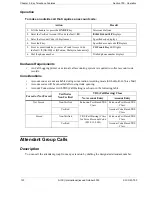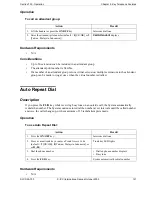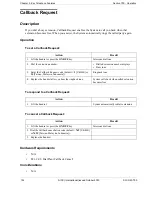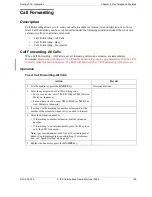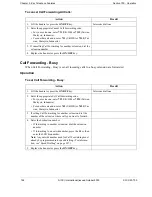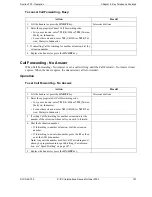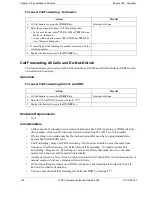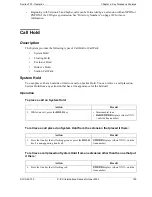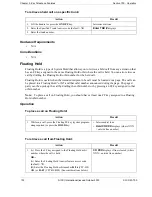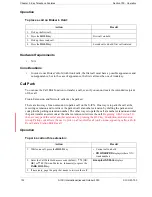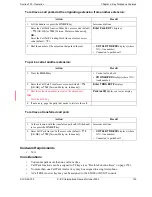
118
S-ICX (International) issued October 2000
S-ICX-50-700
Chapter 5. Key Telephone Features
Section 700 - Operation
Hardware Requirements
•
N/A
Considerations
•
Calling parties without a display get a ring back tone, rather than the Absence Message.
•
If a message code number that has not been programmed is selected,
Absence No.n
, appears on
the display (n = message number).
•
Regardless of setting an Absence Message on a DDI/DL extension, DDI/DL calls are routed
according to the trunk ringing setting.
•
An absence message may also be cancelled by dialling
7**
. This cancels Do-Not-Disturb (DND)
and Call Forwarding-All Calls as well.
Account Codes
Description
You can assign account codes to clients to facilitate billing and to track call dates and times, numbers
called, and outside line numbers used. This information is printed for each account on the System
Message Detail Recording (SMDR) (Call Logging) record.
In addition verified account codes may be used to change the TRS (Call Barring) level to allow calls
to numbers otherwise restricted.
Account codes may be either forced or unforced (voluntary) and either verified or unverified.
This feature works with SMDR (Call Logging). During a phone call, a station user can silently enter
an accounting or client billing code. The entered Code will display on the phone’s LCD as it’s dialled,
so the user can tell it’s being registered. Then later, the Call Logging reports will show the Code
dialled for each call, and even sort the report by these Codes.
There are two different types of account codes: Non-Verified and Verified Account Codes. Prior to
Version 5.0, the maximum amount of account code numbers for both types could range from 1-10
digits. Beginning with Version 5.0, a second mode has been added that allows the user to set the
maximum amount of account code numbers from 1-4 digits. An account code error will occur when
more than the maximum number of digits are entered.
Non-Verified Account Codes
Non-Verified Codes aren’t checked by the system for validity.
Depending on the setting, the user can
enter anything from 1-4 digits or 1-10 digits.
Individual phones can be programmed to accept
forced
Account Codes
(the user must enter a code for every call) or
voluntary
Account Codes
(the user can
enter a code, but doesn’t have to, for each call).
Non-Verified Account Codes can be assigned to incoming and/or outgoing calls. For incoming calls,
the user can enter the Code anytime during the call. For outgoing calls, the user either enters the Code
before accessing an outside line (for
forced
Codes), or anytime during the call (for
voluntary
Codes).
Verified Account Codes
Verified Account Codes entered by phone users must match a code that has been preprogrammed into
an Account Code Table.
Depending on the setting, the user can enter anything from 1-4 digits or 1-10
digits.
These codes can also be either
forced
or
voluntary.
You can program these codes with their own
Содержание S-ICX
Страница 262: ...262 S ICX International issued October 2000 S ICX 50 700 Chapter 6 DSLT Features Section 700 Operation ...
Страница 310: ...310 S ICX International issued October 2000 S ICX 50 700 Chapter 7 SLT Features Section 700 Operation ...
Страница 314: ...314 S ICX International issued October 2000 S ICX 50 700 Section 700 Operation ...

